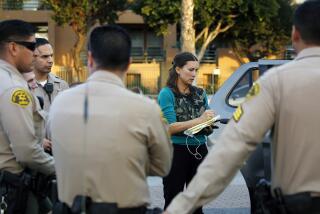Judge Delays Hearing on Order Barring Times Story
- Share via
SAN DIEGO — A judge put off until Wednesday a hearing on an order that he issued barring The Times from publishing information about security measures installed at the home of San Diego County Sheriff John Duffy.
San Diego Superior Court Judge Jeffrey T. Miller refused, after a closed meeting Friday in chambers with lawyers for The Times and for Duffy, to lift the order that he issued late Thursday. Miller did, however, make a single but significant change in the order, one that an attorney for The Times said would enable the publication of a broad range of information.
Even with that change, the attorney, Los Angeles lawyer Rex S. Heinke, said Miller’s order remained “an unconstitutional prior restraint” on the freedom of the press.
“I don’t think there’s any basis for enjoining the publication of information about security measures at the sheriff’s home, particularly when what the Los Angeles Times was primarily interested in was how much these measures cost and who was paying for them,” Heinke said.
In seeking the court order late Thursday, a lawyer for Duffy told the judge that she believes any article about security measures at Duffy’s newly built Scripps Ranch house could seriously compromise the personal safety of the sheriff and his wife, Linda.
The lawyer, Janet B. Houts, said Friday that the case “most certainly” involved issues of press freedom.
“But the cases I’ve researched hold that the right to privacy in this particular case, when someone’s safety is at stake . . . will override any type of newsworthiness on an issue such as this, when it’s not newsworthy,” Houts said.
Dale Fetherling, editor of the San Diego County Edition of The Times, said Houts’ claim--that the story The Times was pursuing would threaten the lives of Duffy and his wife--is “preposterous.”
The dispute began Thursday afternoon when a Times reporter, Richard A. Serrano, called the Sheriff’s Department and asked about what Serrano had been told was an “extraordinary” security system at Duffy’s home, Fetherling said in a statement released Friday.
The purpose of the possible story was “not to endanger or allow anyone else to endanger the sheriff,” Fetherling said.
“Its purpose was--is--to find out if this supersecurity system exists, and if so, what are the public policy implications,” he said.
Early Thursday afternoon, at the time Serrano made his initial inquiries about the security system to Sheriff’s Sgt. Jim Cooke, a department spokesman, no decision had been made to publish or not publish a story, Fetherling said.
But since the paper would not agree to not publish information about any security measures, Houts said, she had no choice late Thursday but to go to court. Miller issued an order directing The Times not to print information regarding the “nature, layout or configuration of security measures” in Duffy’s home.
After Friday’s hearing, Miller substituted the word “location” for “nature” but let the rest of the order stand.
The change “makes a big difference,” Heinke said, because “nature” is “one of those vague words,” while “location” is much more specific.
With the change, The Times is “certainly entitled to say, for example, he has an electronic security system or he has an electronic fence.”
Legal experts said Friday that the First Amendment does not explicitly bar all “prior restraints,” the legal phrase for the blocking of news stories and broadcasts before their dissemination. But in several major cases, the U.S. Supreme Court has held that prior restraint violates the free-press provisions of the Constitution.
“Prior restraints have been tried many times,” San Diego attorney John Allcock said. “Even in severe areas like national security they haven’t been upheld. And so I don’t see why this would be any different, why (Duffy’s) assertions would justify it.”
More to Read
Sign up for Essential California
The most important California stories and recommendations in your inbox every morning.
You may occasionally receive promotional content from the Los Angeles Times.













